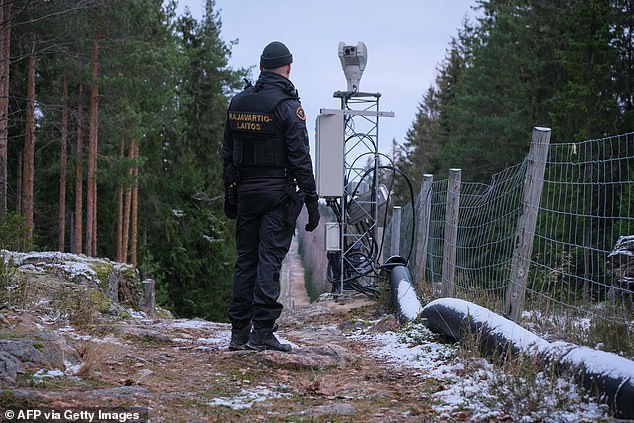Russia has begun building new military infrastructure along its border with Finland, in a move Finnish army officials have described as a deliberate attempt to test NATO‘s alliance and resolve.
Lieutenant General Vesa Virtanen, Finland’s Deputy Chief of Defence, expressed concerns over Russia’s actions, stating that the Kremlin is ‘deliberately testing NATO’s unity’ to see if it will trigger Article 5 – the alliance’s collective defence clause.
Speaking to German newspaper Welt, Virtanen claimed: ‘Russia has been testing Article 5 the whole time with mass migration, with cyber attacks, with GPS jamming, and attacks in the information space.’
He believes Russia are testing to what extent it can act without Article 5 being triggered, as their latest move sees the country erecting new equipment to station Russian troops along its border.
‘During the war there were about 20,000 soldiers stationed and about four standby brigades, now we see that Russia is building new infrastructure and as soon as they can, more troops in this region,’ Virtanen warned.
The army chief explained that they are reorganising themselves from the brigades and there would likely be around four to five divisions, an army corps, and a supporting unit.
‘So there will be more troops there in the future than before the Ukraine war,’ he added, while reassuring that Finland has been ready to defend its allies for decades.
The move comes after Finland’s accession to NATO on April 4, 2023, which extended the alliance’s border with Russia by over 1,300km.

Finland’s Deputy Chief of Defence warned that Russia is building new military infrastructure along its border with Finland. Pictured: Border guard stands near a fence marking the boundary between Finland and the Russian Federation near the border crossing of Pelkola, in Imatra, Finland on November 18, 2022

The army chief explained that Russian troops are reorganising themselves from the brigades and there would likely be around four to five divisions, an army corps, and a supporting unit along the border

Virtanen claimed Russia are testing to what extent it can act without Article 5 being triggered. Pictured: Russian President Vladimir Putin
In response to Finland’s NATO membership, Russian President Vladimir Putin announced the establishment of the ‘Leningrad Military District’ near the Finnish border and the deployment of additional military units to the area.
Despite these actions, Putin has dismissed concerns over a potential attack on NATO members as ‘complete nonsense’, asserting that Russia has no interest in engaging in conflict with the alliance.
Finnish officials have also reported an increase in hybrid tactics employed by Russia, including the orchestrated movement of asylum seekers to the Finnish border, which Prime Minister Petteri Orpo described as a ‘hybrid attack’ aimed at destabilising Finland and the EU.
In anticipation of potential threats, Finland has initiated the construction of a 200km border fence to enhance security and reduce reliance on Russian border controls.
Similarly, Poland and the Baltic states last year demanded the EU strengthen its 2,400km eastern border as it warned of a ‘looming threat’ from Russia and Belarus.
In their letter, the leaders of Poland, Estonia, Latvia and Lithuania urged the 27-nation EU to ‘spend more and coordinate on defence initiatives within the EU and with NATO’ in order to protect the bloc of 450 million people.
‘Building a defence infrastructure system along the EU external border with Russia and Belarus will address the dire and urgent need to secure the EU from military and hybrid threats,’ they said.
Finland’s defence strategy involves allowing an invading force to initially cross the border, only to be met with a robust counteroffensive.
‘The Finnish thinking has been to allow the enemy to advance a little inwards and then beat them back,’ military policy expert Lieutenant Colonel Juhani Pihlajamaa told Finnish broadcaster Yle last year.


European leaders have said the invasion of Ukraine could soon break out into a ‘global’ war
This approach is supported by Finland’s maintenance of a large reserve force and significant artillery capabilities, ensuring readiness in the face of aggression.
As tensions escalate, Finland’s integration into NATO’s defense framework continues, with the establishment of a new NATO command center in Mikkeli, less than 200 kilometers from the Russian border.
NATO officers assigned to the Multi Corps Land Component Command (MCLCC) will begin arriving in Mikkeli later this year, according to the city’s mayor, Janne Kinnunen.
Kinnunen told Yle last week that between 10 and 15 officers will begin arriving in the city as early as autumn this year, although the number of arrivals is expected to climb much higher.
But Finland is not the only country foucisng on their defence against Russia and a possible expansion of the bloody war.
In March, the EU pushed for every household in the 27-nation bloc to have a three-day survival kit ready in case of war or natural disasters.
EU crisis management commissioner Hadja Lahbib said the proposals would be formally presented as part of a broader ‘preparedness strategy’.
Brussels is hoping to ensure every citizen is equipped for 72 hours of self-sufficiency amid the growing threat of continental conflict breaking out.
EU citizens will be told to stock up on a dozen key items, including matches, ID documents in a waterproof punch, bottled water, energy bars and a flashlight, as part of their ‘resilience’ kit.
European leaders have said the invasion of Ukraine could soon break out into a ‘global’ war.
Some Scandinavian countries have already stepped up their preparation by distributing war survival guides.
This article was originally published by a www.dailymail.co.uk . Read the Original article here. .

